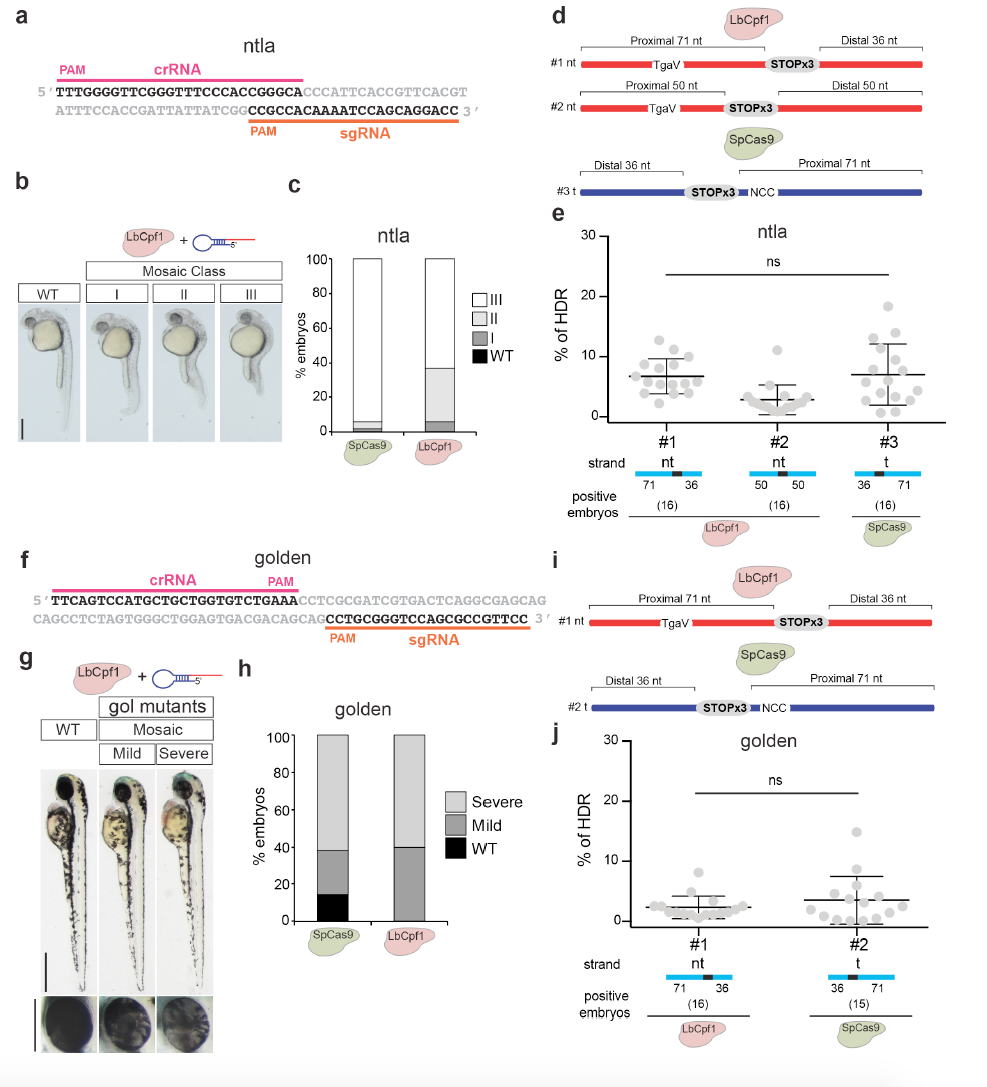Fig. S11
LbCpf1-mediated homology-directed repair in ntla and golden loci.
a. crRNA (pink line) and sgRNA (orange line) target sequences in the ta (ntla) locus used for this analysis.
b. Phenotypes obtained after injection of the LbCpf1-crRNA and SpCas9-sgRNA RNP complexes (10 fmol) targeting ntla in zebrafish embryos (Lateral views). Levels of mosaicism compared to wild type (WT) were evaluated at 30 hpf. Class I: Short tail (least extreme). Class II: Absence of notochord and short tail (medium level). Class III: Absence of notochord and extremely short tail (most extreme). Scale bar, 0.36 mm.
c. Stacked barplots showing the percentage of different mosaic mutants described in b.
d. Schema illustrating different donor ssDNA (#1-#2) complementary to the target strand (t) and with symmetric or asymmetric homology arms used in combination with LbCpf1-crRNA. PAM sequence was modified (TgaV/ActB) to prevent new editing post-HDR. An optimized ssDNA donor (#3) described for SpCas9-induced HDR8 was used in combination with SpCas9-sgRNA RNP as reference for comparison (bottom).
e. qPCR quantification showing percentage of HDR from individual embryos when using LbCpf1 and different ssDNA donors in comparison with SpCas9 in the conditions described in d. To measure % HDR, specific primers to amplify DNA integrations were used following a similar approach described in Supplementary Fig. 10b and h, and albino genomic primers were used to estimate genomic DNA amount (Supplementary Data 1, see Methods). % of HDR: amount of integrated DNA per total amount of genomic DNA per embryo (see methods for details). Results are shown as the averages ± standard deviation of the means from 16 embryos in two independent experiments (n=8 embryos per experiment). Embryos showing a PCR amplification signal detectable by qPCR were considered positive. The data were analyzed by Kruskal-Wallis test followed by Dunn’s post-test for significance versus control condition (#3). No significant (ns) differences were found between LbCpf1 and SpCas9 in the optimized conditions (#1 vs #3).
f. crRNA (pink line) and sgRNA (orange line) target sequences in the slc24a5 (golden) locus used for this analysis.
g. Phenotypes obtained after injection of the LbCpf1-crRNA and SpCas9-sgRNA RNP complexes (20 fmol) targeting golden in zebrafish embryos. Lateral views (top; scale bar, 0.5 mm) and insets of the eyes (bottom; scale bar, 0.25 mm) of the embryos at 48 hpf are shown.
h. Stacked barplots showing the percentage of different mosaic mutants described in g.
i. Schema illustrating a donor ssDNA (#1) complementary to the target strand (t) and with asymmetric homology arms used in combination with LbCpf1-crRNA. PAM sequence was modified (TgaV/ActB) to prevent new editing post-HDR. An optimized ssDNA donor (#2) described for SpCas9-induced HDR8 was used in combination with SpCas9-sgRNA RNP as reference for comparison (bottom).
j. qPCR quantification showing percentage of HDR from individual embryos when using LbCpf1 in comparison with SpCas9 in the conditions described in i. To measure % HDR, specific primers to amplify DNA integrations were used following a similar approach described in Supplementary Fig. 10b and h and albino genomic primers were used to estimate genomic DNA amount (Supplementary Data 1, see Methods). % of HDR: amount of integrated DNA per total amount of genomic DNA per embryo (see methods for details). Results are shown as the averages ± standard deviation of the means from 16 embryos in two independent experiments (n=8 embryos per experiment). Positive Embryos: number of embryos per condition showing a detectable qPCR amplification signal. The data were subjected to unpaired two-tailed Mann-Whitney test and no significant differences (ns) were found between LbCpf1 and SpCas9.

